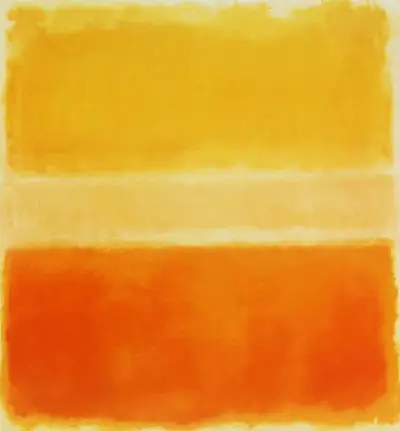Yellow and Gold, 1956
Mark Rothko's paintings had become quite abstract by the end of the 1940s due to years of experimentation. His signature style had also emerged around this time, which involved two or three rectangles that are set on a background that simultaneously differentiates them while at the same time uniting them compositionally.
Style and technique
The edges on Rothko's forms are not distinct. Therefore, this allows eyes to move easily from one area to another. He did this since he did not want viewers to think much about him while looking at his paintings, as he put in much effort to get rid of the evidence involved in the creative process.
For instance, he used thin layers of paint using a rag or brush on an unprepared canvas. This procedure allowed for the pigment to soak in and be part of the surface. This layered wash of pigment achieved an effect of luminescence.
Rothko wanted to express some emotions through this palette as he saw it to be a door into another reality. He explained that those who cry before his pictures have the same religious experience while painting them.
Influences and inspirations
By the time he painted yellow and gold, Rothko worked for thirty years as a painter. In the 1920s and 1930s, his paintings reflected realistic trends that were dominant in American art. He also perpetuated figures like Thomas Hart Benton.
At the beginning of world war I, and through the great depression, most canvases looked to Europe for forms drawn by artists like Dali, Miro Picasso and Rothko's predecessors. Rothko strived with a single goal of becoming all-consuming in accessing an alternative realm. He wanted to transcend his worldly existence. He wanted to release his viewers and himself from what he saw to be a chaotic experience of our daily lives.
Rothko succeeded in making his art instrumental in his inner life. His paintings stopped being material expressions and transformed into gateways leading to the sublime.
Yellow and gold show its allure that is greater than human and engulfs the viewer's entire experience and displays viewers as actors in his epic work. His painting is large as he wants to be intimate and human. He says that painting a small picture is like putting yourself outside your experience. He further says that if the painting is large, you live inside it. it's not something that you command.
As he painted the yellow and gold artwork, scale played a very fundamental role as the surface exhales color through an enveloping effect enhanced by size. He believes that a viewer will react to a picture on the wall the same way he/she reacts to an environment. Till today, Rothko's paintings play a major role in attaining the highest realm that inspires us.

